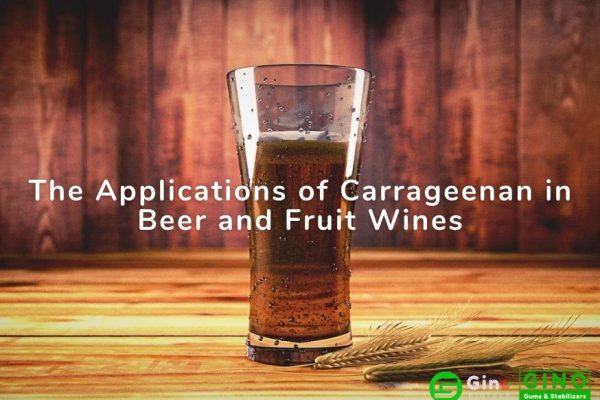Introduction to Hydrocolloids in Beverages | Beverage Stabilizers
Tables of Contents | Beverage Stabilizers
1. History of Hydrocolloids
The earliest application of hydrocolloids can be traced back to ancient Egypt, Europeans were familiar with acacia bean gum, and China began to grow konjac in the Jin Dynasty. With the progress of social production, more and more hydrocolloids are used in food and pharmaceutical applications. So far there are more than 40 kinds of hydrocolloids available in the world for the food industry, and their sources and distribution are very wide.

Hydrocolloids are large polysaccharides, whose basic chemical units are monosaccharides and their derivatives. Some hydrocolloids also contain non-sugar parts, this special chemical composition gives hydrocolloids very special properties, usually as gelling agents, thickeners, emulsifiers, film-forming agents, water-holding agents, adhesives, suspending agents, clarifying agents, foam stabilizers, lubricants and other applications in food.
2. Types of Hydrocolloids
There are many types of hydrocolloids, such as alginate, carrageenan, xanthan gum, locust bean gum, guar gum, and pectin.
In the production of beverages, hydrocolloids can not only be used as thickeners and gelling agents but also control the liquidity and texture of liquid food, change the deformability of semi-solid food and so on.
Usually, the concentration of 0.025-0.5% can produce viscosity and form gel, which can effectively improve the sensory properties and increase the stability of beverages.
How to choose beverage stabilizers?
Suitable types of colloids should be selected for beverage production. The following factors should be considered when selecting hydrocolloids.
- Stability under the same pH conditions
- The effect of electrolytes on the colloid
- Synergy with other components of the food (sugars, salts, proteins and other additives)
- Structure of the product (transparency, cloudiness) and taste (crispness, fullness)
- Ease of use (solubility, storage stability)
- Price or relative cost
- Food additive regulations, etc.
Usually, a single colloid does not meet all the conditions of application in the same beverage. Therefore, different edible colloids should be compounded to produce 1+1>2. 1+1=2 or even 1+1<2 to achieve the desired application effect. Let's talk about the application characteristics of hydrocolloids for some common types of beverages in the market.
3. Acidic Fruit and Vegetable Juice Beverage Stabilizers

The pH value of acidic fruit juice drinks is usually less than 4.0, and it is difficult for bacteria with high heat resistance to grow and multiply below pH 4.0. Therefore, its sterilization object is mostly moldy surface or yeast with poor heat resistance. To maintain the freshness of juice, pasteurization or atmospheric pressure boiling water sterilization is usually used.
And the pH of most acidic sparse vegetable juice is around 5.0, its pH is relatively high, so the object of sterilization is the thermophilic bacteria, must use high temperature and high pressure sterilization. Therefore, the choice of stabilizers for acidic juice drinks and acidic vegetable juice drinks should be different: the former should use stabilizers with stronger acid resistance, such as instant pectin, instant xanthan gum, propylene glycol alginate, etc. The latter should choose the stabilizer with stronger heat resistance, such as instant xanthan gum and instant CMC, etc.
In addition, fruit and vegetable juices usually have high requirements for taste, not only to have a sense of fullness and must be crisp, so you should choose a larger viscosity and relatively weak gel characteristics of the stabilizer. Such as instant xanthan gum, propylene glycol sea bleach and instant CMC, etc. If the juice contains a large amount of pulp or fruit fiber, you should choose a larger viscosity, gel ability, such as low-temperature activation type agar, instant pectin and suitable compounding colloid.
4. Dairy Beverage Stabilizers

Dairy beverages are usually composed of fruit juice, fresh milk or dairy products (fermented milk), sweeteners and stabilizers.
Liquid milk often suffers from the following quality defects during production and storage.
(1) Neutral liquid dairy products produce poor flavor, fat floating, protein coagulation, transparency, lack of milk flavor, stratification, and precipitation.
(2) Acidic liquid dairy products are prone to acidity, whey precipitation, fat floating, protein precipitation, stratification, poor taste, and lack of milk flavor.
Therefore, there is also a potential risk of the above quality defects in dairy beverages made from liquid milk or reduced liquid milk.
At the same time, the milk protein is easy to coagulate and precipitate with pectic acid, pectin and tannin in the juice. Therefore, how to choose suitable stabilizers to solve the above problems is the top priority when developing dairy beverage formulations.
Instant pectin, instant xanthan gum, propylene glycol alginate and instant CMC can be used as emulsifying stabilizers to increase the stability of dairy beverages.
Neutral milk-containing beverages can also choose carrageenan, etc., as emulsification stabilizers.
In addition, stabilizers dedicated to neutral dairy beverages such as peanut milk, coconut milk, walnut milk, almond milk, sesame milk, sweet milk, soy milk, coffee milk, chocolate milk, etc. and stabilizers dedicated to acidic dairy beverages (capable of protecting proteins under acidic heating conditions to enhance the smoothness of the beverage) can be provided.
5. Stabilizers for Carbonated Beverages

Carbonated beverages usually require essential oils to be made into emulsified flavors or main agents in the production process, so emulsification stabilizers have an important role in the production of carbonated beverages.
Among the hydrocolloids, gum arabic and modified starch are the most widely used hydrocolloids for making such emulsified flavors or main agents.
In addition, to enhance the emulsification ability of gum arabic graft modification on the basis of traditional gum arabic to produce modified gum arabic, which brings the possibility of making high-fold emulsified flavors and saving the formulation cost of emulsified flavors.
6. Meal Replacement & Functional Health Drinks Stabilizers

With the popularity of herbal tea across the country, a series of functional health drinks and food substitutes have started to emerge in the market.
Hydrocolloids play an important role in the production of these beverages. Firstly, within the scope of regulations, hydrocolloids can be added to beverages as dietary fibers such as gum arabic, inulin and guar gum to remove the fishy taste of beans, etc.
Secondly, hydrocolloids also have the functions of preventing sedimentation, stratification, protecting cereal protein, controlling water absorption and swelling of crude fibers, and preventing starch aging during the shelf life in pure cereal meal replacements containing a large amount of crude fibers. starch aging during the shelf life.
Compounding stabilizers are one of the good choices to solve such product quality problems.
7. Solid Beverage Stabilizers

Hydrocolloids in solid beverages have the function of enhancing the taste and suspending fine solid particles that are insoluble in water (e.g. tea powder, coffee powder, cocoa powder).
Since brewability and immediacy are crucial for solid beverages, it is necessary to choose stabilizers with strong instant solubility and strict microbial control. Such as instant xanthan gum, instant agar, de-soyed guar gum and carrageenan, etc.
8. Other Beverage Stabilizers

Propylene glycol alginate can be used as a foam stabilizer in alcoholic beverages such as beer.
In the oral spray-type liquid candy (a low-acid beverage), which has a pH of only 1.5-2.1, there is a need for instant xanthan gum and instant pectin, which are more acid-resistant.
In recent years, the speed of beverage innovation is fast, and many new and interesting nutritious and delicious beverages are emerging in the market, so the application of hydrocolloids in beverages will certainly be more and more, and the perfect application technology requires the joint efforts of beverage formulation developers and hydrocolloid developers and applicators.
Related Articles
Recent Posts

We are a biotech company specialized in the research, development and commercialization of innovative and technological food additives hydrocolloids Agar Agar, Carrageenan and Tailor-Made Stabilizer Solutions.
With the extended know-how and experience in the research, application and use of Hydrocolloids, we could provide one-stop-shop customized solutions perfectly matched to the needs of our customers.
Our products cover the needs of the Meat, Dairy, Bakery, Confectionery and other industrial sectors.













